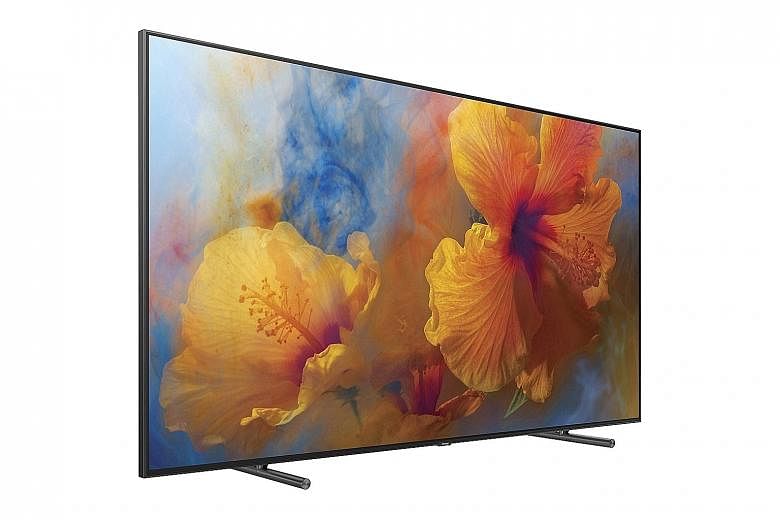The Samsung Q9F is a very good television set. It is, after all, the company's flagship model this year. But it is also an ingenious piece of marketing.
You see, Samsung calls the Q9F a Qled or quantum-dot light-emitting-diode television set. This acronym is new, but the underlying technology is similar to its high-end TV sets from last year. Basically, the screen has a thin film of quantum dots, or nanocrystals, that emit bright and accurate colours when light hits them.
Samsung's Qled acronym suggests an equivalence to the Oled (organic light-emitting diode) TV sets that are widely regarded as superior to those with LCD screens. But Qled sets are essentially LCD ones, just with an LED backlight and a quantum-dot film.
To be fair, Samsung says it has upgraded its quantum-dot technology this year by adding a metal coating to improve colour accuracy. The Q9F has been certified to reproduce 100 per cent colour space for the DCI-P3 standard preferred by film makers.
LCDs can, thanks to their LED backlights, produce extremely bright images. The Q9F takes this to a new level - it can become blinding, especially in a dark room. Its brightness means that, even in a well-lit room, its colours still look dynamic and vivid. Reflections are not as evident as they would be on a dimmer screen. Since most of us do not watch TV in the dark, this is a plus for home users.
In addition, it upscaled HD content very well from my StarHub cable service, with good detail and reasonable sharpness.
However, Qled TVs do not fix the inherent flaws of LCD TVs. For instance, the Q9F looks great when viewed directly in front of it. But the view from the sides is not as impressive - images look slightly more washed out, with a greyish cast.
-
TECH SPECS
-
PRICE: $8,999 (65-inch)
PICTURE FEATURES: Maximum resolution of 3,840 x 2,160 pixels, HDR
AUDIO FEATURES: 60W output, Dolby Digital Plus, DTS Premium Sound 5.1
OPERATING SYSTEM: Tizen OS
CONNECTIVITY: 4 x HDMI, 3 x USB, Digital optical output, Ethernet, Wi-Fi
-
RATING
-
FEATURES: 4/5
DESIGN: 4/5
PERFORMANCE: 4/5
VALUE FOR MONEY: 3/5
OVERALL: 4/5
This is unlike Oled screens that look good from any angle.
The Q9F also fails to match the deep, practically infinite blacks that is the main selling point of Oled screens. For an LCD TV, though, the Q9F is excellent in this department.
However, it has a similar vertical banding issue as last year's models. It is more prominent when viewing a mostly static scene with a light background - like a light blue sky or a football field. You'd hardly notice it in a movie, but it is distracting once you see it.
Because it relies on an LED backlight instead of having each pixel produce its own light, the Q9F will not astound you with an ultra-thin side profile.
And, instead of trying to achieve that, the Q9F goes with a sturdy metal frame that is good-looking in its own way.
Samsung also sells two optional stand accessories for those who prefer a unique look. The studio stand looks elegant with its dark brown easel design while the full-metal gravity stand can swivel by up to 35 degrees.
Like most high-end TV sets, the Q9F's connectors are found in a separate external box.
This box is connected to the screen via a thin optical fibre cable and offers a full complement of four HDMI 2.0 ports and three USB ports. It is larger than last year's version and requires its own power cable, which means the TV set takes up two power sockets altogether.
The bundled remote control is also made of metal, which is an improvement over the plastic version from last year. It still has a few buttons, which may be too minimalist for some. The TV's Tizen operating system makes up for it with a set of powerful voice commands. Convenient as they may be, these commands do require users to learn them, unlike a traditional remote control.
The Smart Hub interface is similar to last year's, though with a brighter theme. Perhaps because I own a Samsung set, I found it the easiest interface to navigate, compared with its rivals. My favourite part is that the TV set automatically detected other connected devices, such as the StarHub TV set-top box and the PlayStation 4 console, allowing me to control them with the TV remote control.
It even added my network drive without prompting and streamed videos from it flawlessly.
• Its picture quality falls slightly short of the top Oled models, though it is not as pricey. More importantly, it sets a new standard for brightness levels that, coupled with its good upscaling, makes it an excellent choice for normal home usage.


